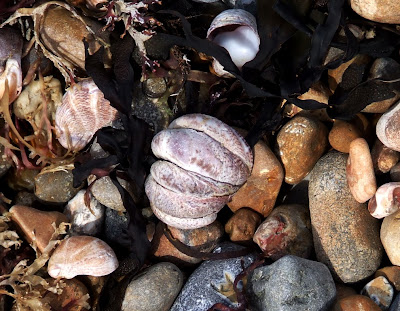
We walked to the end of the harbour arm where a couple of fishing boats chugged along underneath a cloud of seagulls wheeling overhead. Within the harbour mouth a great crested grebe dived periodically beneath the water. Not a common bird in this area but I have noticed reports over the years of Great Crested Grebe on the sea at Shoreham.
 On the way back to the car we explored the strandline. The most common strandline objects were the clumps of whelk eggs. Usually washed ashore after the eggs had hatched, due to the stormy seas some of the egg capsules still had eggs. There were also large piles of slipper limpet shells that had been washed up together. There was also a dead spider crab and numerous dead starfish amoungst the debris.
On the way back to the car we explored the strandline. The most common strandline objects were the clumps of whelk eggs. Usually washed ashore after the eggs had hatched, due to the stormy seas some of the egg capsules still had eggs. There were also large piles of slipper limpet shells that had been washed up together. There was also a dead spider crab and numerous dead starfish amoungst the debris. There were numerous empty dogfish eggcases and a few ray egg cases (Dogfish egg case below)
There were numerous empty dogfish eggcases and a few ray egg cases (Dogfish egg case below) We also found about a dozen scallop shells (below) and several oyster shells, the latter had both halves (valves) still intact.
We also found about a dozen scallop shells (below) and several oyster shells, the latter had both halves (valves) still intact.  Afterwards we drove along the coast to Hove beach for a hot drink and to further explore the strandline. My wife Sharon and our friend Xena had visited this beach yesterday and said there was lots to see.
Afterwards we drove along the coast to Hove beach for a hot drink and to further explore the strandline. My wife Sharon and our friend Xena had visited this beach yesterday and said there was lots to see. There were many slipper limpet shells on this beach as well. I also found a stack of live slipper limpets, 5 stuck together in a stack.
There were many slipper limpet shells on this beach as well. I also found a stack of live slipper limpets, 5 stuck together in a stack. The bottom slipper limpet is a female the rest are males. If the female dies, for example if they are dislodged in a storm, the next male will change sex and become female. Unlike the common limpet, slipper limpets are plankton feeders.
The bottom slipper limpet is a female the rest are males. If the female dies, for example if they are dislodged in a storm, the next male will change sex and become female. Unlike the common limpet, slipper limpets are plankton feeders. There were also numerous whelk eggcases here too (see above). A few dogfish eggcases and a larger number of ray eggcases (see below), 14 which I found on just one area of the beach.
There were also numerous whelk eggcases here too (see above). A few dogfish eggcases and a larger number of ray eggcases (see below), 14 which I found on just one area of the beach. I found the remains of a small sea urchin (below). Not an empty test (this is what the shell is called) unfortuantely but the dead remains with the spines missing. If you look carefully at the image below you will notice the tube worm on the slipper limpet shell, top left.
I found the remains of a small sea urchin (below). Not an empty test (this is what the shell is called) unfortuantely but the dead remains with the spines missing. If you look carefully at the image below you will notice the tube worm on the slipper limpet shell, top left. The other unusual find was a clump of eggs about 10 cm across. The nearest thing I had seen to this is lumpsucker fish eggs. The female lumpsucker lays her eggs close to shore and leaves them to be guarded by the male.
The other unusual find was a clump of eggs about 10 cm across. The nearest thing I had seen to this is lumpsucker fish eggs. The female lumpsucker lays her eggs close to shore and leaves them to be guarded by the male.
1 comment:
Interesting reading Steve, I have linked you on my Lancing Blog
http://lancingnature.blogspot.com/2008/03/from-stormy-seas.html
no need to reciprocate.
Post a Comment